![]()
Recent Articles

Get
Michael Vaughan's Buying Guide for today's Vintages Release today!
With a special $20 Discount
Click Here
Don't
change wine, change the glass!
There
is no such thing as the perfect wine glass for everyone
©
Michael Vaughan 2006
National Post
Weekly Wine & Spirits Columnist
Saturday,
August 26, 2006
click here to see the National Post printout of this article
LIVE
WINE LINK
www.winefind.ca
(CLICK ON THE NAME - All
listings are automatically linked to the LCBO database)
If there is a product that interests you,
just click on the name below and you will instantaneously connected with
the LCBO database. The product will appear in blue and all you have to do
is click on the name again
and then the next screen will provide details along with the store search.
Just click on store search.
The number of bottles in each store is updated nightly. Call
the store first to see if stock still remains (each store phone number is
listed).
Beware, the glass, which makes your Chardonnay terrific, can make you Sauvignon Blanc taste like crap. It's a fact; the shape of the glass makes the wine. This is the most important thing you will ever learn about wine appreciation. This isn't wine snob propaganda; it is a reality that affects everyone from neophyte to expert. It is shocking to think that everything else - terroir, climate, type of oak, etc. can be destroyed by using a glass that makes a wine taste bad.
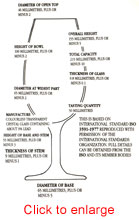 About
30 years ago, the special ISO
glass was born, which is now used internationally for all major wine
judgings. This ISO glass has a fairly neutral impact smell and flavour.
Other specialty glasses, however, have an enormous impact on how a wine
actually tastes. At tasting events organized across Canada, people were
truly amazed to see to how great these differences can be. Sometimes, they
didn't believe that I had put the identical wine in the two
differently-shaped glasses. When they tried it for themselves, they were
shocked.
About
30 years ago, the special ISO
glass was born, which is now used internationally for all major wine
judgings. This ISO glass has a fairly neutral impact smell and flavour.
Other specialty glasses, however, have an enormous impact on how a wine
actually tastes. At tasting events organized across Canada, people were
truly amazed to see to how great these differences can be. Sometimes, they
didn't believe that I had put the identical wine in the two
differently-shaped glasses. When they tried it for themselves, they were
shocked.
It is sad that so many writers tend to gloss over this reality. After all, if the same wine tastes great (91 points) in one glass, but only so-so in another glass (88 points), then what is the use of these scores? Points only become relevant if provided by a single taster always using the same type of glass. This ensures that their scores are reasonably consistent and comparable. Sadly, it also means that many of the other scores being publicized can verge on being meaningless.
I must admit, that at the beginning, even I was a doubter. "Surely the wine will taste the same regardless of the glass," I thought. In fact, it was Georg Riedel, a10th-generation Austrian glassmaker, who pioneered the notion of different glasses to bring out the best of each wine. Having worked on a Riedel's panel aimed at developing "optimal" stemware, I soon became aware of a glaring problem: there is no such thing as the perfect wine glass for everyone.
The reason is simple. The shape of a glass will increase or diminish each of the numerous characteristics in wine: fruit, acidity, tannin, aftertaste, etc. It is, however, the individual's like or dislike of what the glass highlights (or diminishes) that ultimately determines whether that glass works. While a glass designed for Bordeaux may work for many tasters, it will not be optimal for all!
The corollary? Beware of anyone who tells you that this is the ultimate glass for such and such a wine. Also, if you want to get the most out of a wine, try it with a variety of glasses. You will be amazed that you do not have to own $100 glasses to make your wines taste great. In other words, before changing the wine, change the glass! Also, let me confess that the ISO glass I use rarely makes the wine taste best.
Finally, be skeptical of points, which are simply a snapshot in time. Like all professionals, I use a 100-point system. However, I believe that it is more useful to publish three-star ratings. For 18 years, 200+ monthly reviews have been rated from double-negative (really awful) to three stars (outstanding). By using plus signs (i.e. **+ for excellent), there are many readily identifiable, easy-to-use, qualitative levels for professional buyers. Also, every tasting note is based on using ISO glasses, which have been taken to almost every wine producing country around the globe.
A Rosť & Two Whites
 Moving
on to today's recommendations, which are from a recent wine tasting dinner
held at The Sparrow, a new restaurant
at 92 Ossington Avenue. Entitled tagteam.02
it featured five wines from Henry of Pelham along with four courses. All
26-seats, including a few additional seats at the bar, were sold-out. At
$40, it was a bargain. Better yet, the youthful, enthusiastic crowd loved
every minute. Cranky wine critics, with the exception of myself, were
nowhere to be seen.
Moving
on to today's recommendations, which are from a recent wine tasting dinner
held at The Sparrow, a new restaurant
at 92 Ossington Avenue. Entitled tagteam.02
it featured five wines from Henry of Pelham along with four courses. All
26-seats, including a few additional seats at the bar, were sold-out. At
$40, it was a bargain. Better yet, the youthful, enthusiastic crowd loved
every minute. Cranky wine critics, with the exception of myself, were
nowhere to be seen.
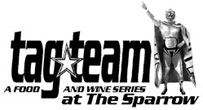 The
highlights were three must-buy, currently-available selections at the LCBO
- just perfect for this last weekend in August. The first is the best
rosť deal in town - Henry
of Pelham 2005 VQA Dry Rosť (613471) at $11.95,
an ex-Vintages Essential, which is now on the General List. This delicious
blend of 67% Zweigelt, 27.5% Cabernet Sauvignon, 4% Syrah and 1.5%
Riesling has refreshing, plummy, raspberry fruit flavours. It is even
better than their just-released 2005 Cabernet Sauvignon Rosť, which is in
Vintages at $14.95!
The
highlights were three must-buy, currently-available selections at the LCBO
- just perfect for this last weekend in August. The first is the best
rosť deal in town - Henry
of Pelham 2005 VQA Dry Rosť (613471) at $11.95,
an ex-Vintages Essential, which is now on the General List. This delicious
blend of 67% Zweigelt, 27.5% Cabernet Sauvignon, 4% Syrah and 1.5%
Riesling has refreshing, plummy, raspberry fruit flavours. It is even
better than their just-released 2005 Cabernet Sauvignon Rosť, which is in
Vintages at $14.95!
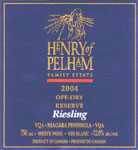 Accompanying
the Atlantic tuna salade Nicoise was Henry
of Pelham 2004 VQA Off-Dry Reserve Riesling
(268375), which is in Vintages at $14.95. It has very appealing spicy,
honeyed, just slightly off-dry (14.5 grams of residual sugar), ripe lemon
and melon flavours with great refreshing acidity on the finish.
Accompanying
the Atlantic tuna salade Nicoise was Henry
of Pelham 2004 VQA Off-Dry Reserve Riesling
(268375), which is in Vintages at $14.95. It has very appealing spicy,
honeyed, just slightly off-dry (14.5 grams of residual sugar), ripe lemon
and melon flavours with great refreshing acidity on the finish.
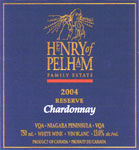 Even
better, this time with a pair of crab cakes was Henry
of Pelham 2004 VQA Reserve Chardonnay (252833),
which is only $13.95 and is readily available on the General List. It hit
the mark with its dry, warm pear puree and vanilla custard flavours.
Extraordinary value, some 28% of the juice was fermented and aged in oak,
which explains the fine structure
Even
better, this time with a pair of crab cakes was Henry
of Pelham 2004 VQA Reserve Chardonnay (252833),
which is only $13.95 and is readily available on the General List. It hit
the mark with its dry, warm pear puree and vanilla custard flavours.
Extraordinary value, some 28% of the juice was fermented and aged in oak,
which explains the fine structure
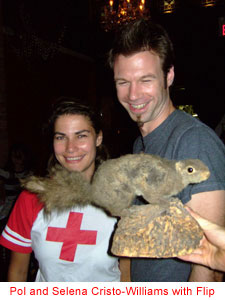
Pol and Selena Cristo-Williams, owners of The Sparrow, are busy planning tagteam.03 for September 13. Their wine list, which features 19 wines by the glass, is well chosen, concise and fairly priced. To see the wine list and menu click here. The H of P Riesling goes for $32 a bottle. It is rumoured that when they can't agree on a wine selection, Pol uses their stuffed pet squirrel Flip to make the decision (as in heads you loose, tails I win).
Pick of the Week
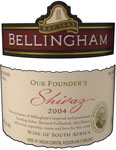 The
recent release of Bellingham
2004 Our Founder's Shiraz (554360) at $13.95 on
the General List is a big step forward. South African Shiraz is definitely
on a roll thanks to Bellingham's founder Bernard Podlashuk who first
created it in 1957. Deep intense purple colour, there is an explosion of
plums and ripe black cherries on the well-structured palate (14% alcohol)
with vanilla-chocolate-mocha notes persisting on the finish. This Shiraz
is sourced in the Coastal Region and the grapes are destalked, crushed and
the juice left on the skins for a 4-day cold soak before fermentation on
the skins with 2 aerations per day. The wine is then pressed - 70 % is
transferred into 10% new American and 20% new French oak casks; the
balance of 30% going into previously-filled oak (90% French and 10%
American), where malolactic fermentation takes place and the wine matures
for a further 13 months.
The
recent release of Bellingham
2004 Our Founder's Shiraz (554360) at $13.95 on
the General List is a big step forward. South African Shiraz is definitely
on a roll thanks to Bellingham's founder Bernard Podlashuk who first
created it in 1957. Deep intense purple colour, there is an explosion of
plums and ripe black cherries on the well-structured palate (14% alcohol)
with vanilla-chocolate-mocha notes persisting on the finish. This Shiraz
is sourced in the Coastal Region and the grapes are destalked, crushed and
the juice left on the skins for a 4-day cold soak before fermentation on
the skins with 2 aerations per day. The wine is then pressed - 70 % is
transferred into 10% new American and 20% new French oak casks; the
balance of 30% going into previously-filled oak (90% French and 10%
American), where malolactic fermentation takes place and the wine matures
for a further 13 months.
2001-2002-2003-2004-2005-2006
Tasting Note Database
Our
tasting note database from December 31, 2000 to August 2006, covers every
Vintages release product for the past 68 months. There are more than 13,000 notes in the database data. Just enter the name of the product,
supplier name or CSPC number. Or you can search by type of wine, country
of origin, even wine agent! Nothing could be easier. Also you can get information on the agent by clicking on the
agentís name, as well as current LCBO store inventory by clicking on
"Check
LCBO Availability", which will automatically tell you the
number of bottles at LCBO as of last night.
To
use our Tasting
Notes Database: click
here
|
** For All Visitors ** To
see the complete list of upcoming
products
from the To
see the complete list of upcoming
products
from the |
Copyright Food & Beverage Testing Institute of Canada
2006
Prior written permission is required for any form of reproduction
(electronic or other wise) and or quotation.
Contact Michael Vaughan at
mbv@total.net